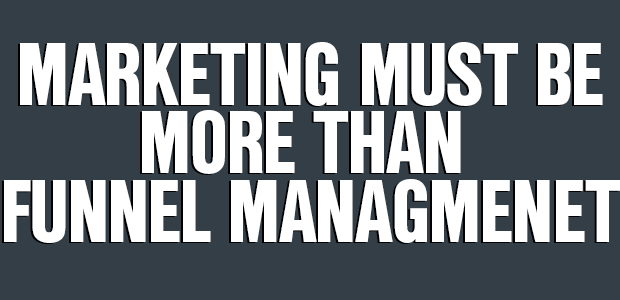Marketing Must Own Strategy (not just funnel management)
Once upon a time, the strategic element of marketing resided within the marketing department, but today the discipline is often absent from the marketing team and sadly may not have found a new home. One of the biggest reasons for this is that the onslaught of marketing automation tools and the drive to content marketing has pushed more marketing teams to become quasi-creative agencies focused mostly on the conversion metrics of early demand. When we dig deeper into the drive to improve early demand what we often find is there is no genuine go to market strategy fueling the content strategy nor the demand generation engine.
This is not at all to suggest that the management and metrics of demand do not matter, but marketing strategy is about far more than greasing the skids of the marketing funnel or passing a lead over to sales. For even the best sales team in the world the struggle begins when they receive a lead. The 2017 State of Inbound Marketing report from Hubspot indicates that 71% of sales respondents struggle most with the earliest stages of their sales process; identifying leads, prospecting and qualifying the deal. Moreover, even in respondents self-reporting well aligned marketing and sales efforts, sales teams turns to marketing generated leads only 25% of the time.
 25% of the time. Only one of every four deals in the sales pipeline is coming from marketing efforts. One of four. Imagine if you could increase that just the littlest bit. The pipeline would be bursting. And surely that has been the promise of marketing automation, no? So what has happened? Marketing automation can sometimes result in not just the marketing team but the entire company taking their eye off the strategic ball. And when this happens the company can never hope to hit that home run through the tactics that they employ.
25% of the time. Only one of every four deals in the sales pipeline is coming from marketing efforts. One of four. Imagine if you could increase that just the littlest bit. The pipeline would be bursting. And surely that has been the promise of marketing automation, no? So what has happened? Marketing automation can sometimes result in not just the marketing team but the entire company taking their eye off the strategic ball. And when this happens the company can never hope to hit that home run through the tactics that they employ.
The promise of content marketing and marketing automation was that you would educate your buyers, ahead of their demand. By delivering on what they were naturally searching for you would be poised to be there to help when their demand crystalized. But guess what? A cacophony of content has muddied the waters, littering the search for information or ideas with poorly developed content that is not at all aligned to what customers actually care about.
Back in the early part of the 00s this sort of problem would manifest itself on a smaller scale. Marketing would wander into a minefield of cliches to describe what they do (world class fully optimized integrated and scalable anyone?). But frequently this muddled gobbledygook stayed at home on the website and rarely entered into the business of identifying leads, nurturing them and moving them into the sales process. The front end of the deal process assisted by the early 00s push of identifying pains and selling the solutions that addressed those pains and delivered value.
Fast forward into the final two and a half years of the 10s, and we find that most content has morphed into a tired combination of marrying the pain, solution, value approach with the cliche-filled jargon of our early century websites. Want proof? Pick any software company and search their site for the exact term “best in class”. When was the last time you ever searched for the “best in class” anything? Or even heard the phrase outside of marketing and advertising.
The solution to the current challenges in marketing is to make a concerted effort to once again place strategy where it belongs, at the center of literally everything you do. Go to market strategies should be simple to understand and incredibly focused. One of the best books on the topic is Playing to Win How Strategy Really Works by A.G. Lafley and Roger L. Martin. Their approach forces a decision on exactly where you will play so that you can win and win big. Once we know where we are going to play, it unleashes a level of focus and commitment to the goal and has the power to energize the entire workforce.
With strategy squarely in place, the next step is to understand that marketing cannot be the only source of content production. Indeed marketing must be considered the editors and curators of the story. This sort of evolution has not occurred in the age of marketing automation because marketing professionals have been relegated to a/b testing download buttons, crafting the perfect newsletter, and churning out tip oriented ebooks to capture as many leads as possible.
Demand generation isn’t marketing. Social media management isn’t marketing. Advertising isn’t marketing. Event management isn’t marketing. Marketing is the marriage of the strategy that the company will employ to win in their chosen playing field with the actions taken to design, develop and sell in the context of that strategy. Marketing has become isolated and relegated to funnel management. The companies that make a decision to place a strategic go to market approach at the heart of everything that they do will have a distinct advantage over companies that are content to have their marketing efforts focus on the funnel.

